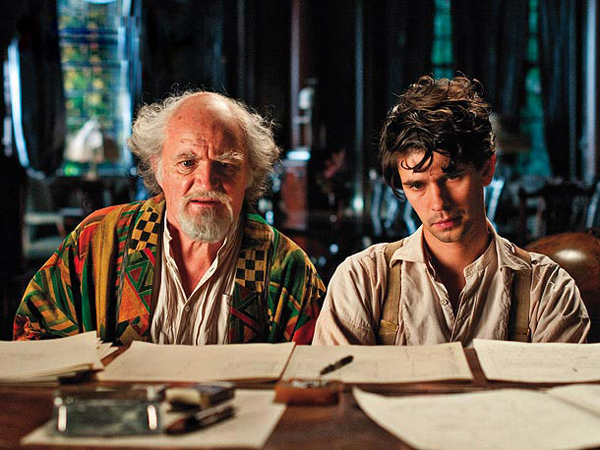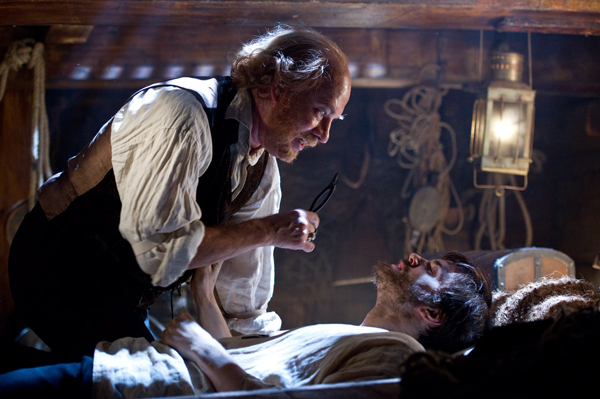Review – Cloud Atlas
|
Cloud Atlas is a beautifully shot and composed film made by great directors who know how to tell compelling stories. It’s not as profound or as gripping as you might hope and doesn’t entirely nail the execution of its “Everything is connected” promise, but it’s certainly an entertaining (if overly long) film.
While I have mixed feelings about it, the best thing I can say about the film is that three days after seeing it, I’m still thinking about it. While so many of the offerings by Hollywood these days are shallow remakes and cookie-cutter formulaic films, it’s nice to have a movie that challenges audiences and gives them something to think about past the trip to the parking lot.
The film spans a wide variety of eras and geographical locations. The one set in the most distant past is a slavery plotline taking place in the Pacific Islands in 1849. Several stories fall in the more recent past, one is set in the present and two take place in the future.
The same actors are used to play different parts in the different storylines. This is perhaps the part of the film that seems the most arbitrary. While there is some notion that these characters are all connected and that people in different eras know each other from past lives, it’s never really explored in detail or explained how or why these specific people keep meeting again.
Also, the actors are given heavy makeup and prosthetics to greatly alter their appearance, so there are times when you don’t recognize someone from storyline to storyline. Outside of Hugo Weaving, who plays an antagonist in every era (the most amusing of which is a very surly and very unattractive woman), most of the actors play very different characters in each plotline.
Often times it just feels like a particular actor had the right build for a character or simply needed a role to play in that particular storyline, instead of some grand plan. It ends up feeling more like a play where actors are asked to perform multiple unconnected roles to streamline the process than any profound decision made by the filmmakers to make a statement about reincarnation or the interconnectedness of life.
The more interesting thing the film does is combine and play with different genres. Each storyline is a different genre, all of them woven together into one long overarcing narrative. The 1849 storyline was a slave narrative taking place in the Pacific Islands. A 1936 story in Cambridge is a coming of age story about a young aspiring composer working with an older, established curmudgeonly composer. There’s a 1973 storyline that follows the classic narrative of a whistle blowing reporter (Halle Berry) looking to unearth the truth about a corrupt company. There’s a present day storyline in London that, after a dark opening, serves mostly as great comic relief. Then there are the futuristic storylines – one taking place in 2044 in “Neo Seoul” and centering around a group of women bred to be servers at a creepy club and the other taking place in a very distant post-Apocalyptic future.
Most of the stories stick to pretty well-worn arcs. The slave narrative and the 70s journalism story in particular feel like plotlines you have seen – presented in basically the same way – hundreds of times before. But by mixing these genres together – and through the use of some meta commentary embedded throughout the film about the different genres and the film’s use of flashbacks and flashforwards – Cloud Atlas is able to take these well-worn plots and make them feel fresh. It’s a bit like listening to a Kanye West song, where he pulls bits and pieces of different songs you’ve heard before and weaves them together to create an entirely new sound.
However, with an almost three-hour running time, by the end all of the stories start to feel overly long. And inevitably some stories will work better for you than others. The ones that don’t grip you (for me, it was the barren, post-Apocalyptic future plotline that worked the least) begin to feel excruciatingly long by the end.
I did really love the Neo Seoul storyline, the (mostly) comic relief one set in modern-day London and the story set in Cambridge in 1936. Also, while Tom Hanks and Halle Berry are both quite enjoyable in the film and likely to garner the most attention, Jim Broadbent, Doona Bae and Jim Sturgess were all really great in their supporting roles.
What really struck me too is just how beautifully shot and edited the film is. It has such vibrant colors and all of the shots are really wonderfully composed. The Wachowskis are among the best at seamlessly integrating CGI effects into their films. There is one moment in this one – featuring Tom Hanks modern-era British character – that integrates the CGI so well and is so unexpected that it got audible gasps from audience members at my screening. All of the prosthetic makeup used is quite good as well.
It’s not a perfect film. It feels overly long and doesn’t entirely deliver on its “Everything is connected” promise. But on a technical level, it’s a great movie. And it feels different than anything you’ve seen, which is an achievement in and of itself these days. If you are looking for something different and aren’t troubled by the three-hour running time, I recommend giving it a shot.
Written by Joel Murphy. If you enjoy his reviews, he also writes a weekly pop culture column called Murphy’s Law, which you can find here. You can contact Joel at murphyslaw@hobotrashcan.com.





Good review! I’m going to see it tonight at IMAX. I read the book recently and from what the film makers say the use of the same actors is supposed to lend to that ‘interconnectedness’ of everyone and the journey of souls through lifetimes to achieve some sort of evolution, or recognizing that love is the most important force over the forces of cruelty. Weaving’s embodiment of a character that is always the antagonist represents a soul that can’t make that change. Which is a lofty ambition for a film! But I am most interested in the themes of civilization and how there are the people who are oppressed and the oppressors. I am sad that the Hawaii post ‘fall’ storyline was the weakest because it was the most powerful in the book in terms of encompassing all of the motifs and thematic elements.
I recommend reading it, because like you say in your review each storyline captures a different genre, and the narrative structure and language in each written story is different. It really is a remarkable read.
[Reply]